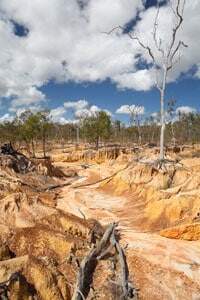 Soil performs a variety of functions, including holding and storing water, organic material and nutrients for agriculture, plant life and human life. Soil erosion is attributed to problems in the agricultural industry, but that is not where the problem ends. You see, erosion contributes to long-term or, if left untreated, potentially permanent environmental repercussions in the form of sedimentation, pollution and flooding. These problems are just the beginning. There are many different types of soil erosion, as well as long-term consequences the earth, ocean and sky.
Soil performs a variety of functions, including holding and storing water, organic material and nutrients for agriculture, plant life and human life. Soil erosion is attributed to problems in the agricultural industry, but that is not where the problem ends. You see, erosion contributes to long-term or, if left untreated, potentially permanent environmental repercussions in the form of sedimentation, pollution and flooding. These problems are just the beginning. There are many different types of soil erosion, as well as long-term consequences the earth, ocean and sky.
Soil erosion increases carbon in the atmosphere.
Earth holds many different types of chemicals and chemical compounds, including carbon and carbon compounds. When soil erosion is a problem in an area of land, the carbon content of the soil is released into the atmosphere and causes atmospheric buildup of carbon and carbon compounds. It is important to maintain good soil conservation, for both solid and gas chemical balance.
Soil erosion interferes with important archaeological data.
When soil erosion causes farmers and other resource harvesters to plow deeper in order to gain minimal nutrients, then this interrupts natural landscapes and archaeological features. This suggests that soil conservation not only satisfies immediate agricultural needs, but also helps to maintain long-term or even almost permanent civilization needs.
Desertification is also a potential consequence of the final stage of soil erosion.
Humid or heavily arid parts of the world, such as the western United States, the Mediterranean, central Asia and India, are vulnerable to unnaturally dry weather if soil erosion occurs on a large scale. For example, these areas and the vegetation and animal life dependent thereon require a humid environment and therefore require maintenance of water supply. If soil erosion occurs, then the vegetation and ground cover for crops and grazing animals disappears, which in turn reduces the organic content of the soil. This reduction of organic nutrients in turn results in soil exhaustion, followed by desertification.
Erodibility versus Erosivity
Erodibility refers to characteristics inherent in the soil which are either susceptible to or strong against agents of erosion and which affect how detachable the soil is and how transportable it is once it is detached. Erosivity refers to how likely agents of erosion, such as wind or water flow or rain fall, are to detach soil in a given area. Erosivity therefore describes conditions surrounding the overall environment of erosion, rather than specific qualities of the soil itself.
Envirosafe Solutions supports soil conservation and any part of landscaping which maintains organic material and nutrients in our soil. Check out our Soil Wetta and dust suppressant on our webpage or call us today: (+61) 1300 88 90 70.



















